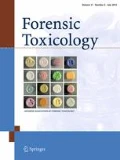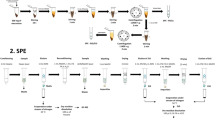Abstract
Purpose
Alcohol exposure during pregnancy constitutes one of the leading preventable causes of birth defects, mental retardation and neurodevelopmental disorders in the exposed children. The ethanol marker ethyl glucuronide (EtG) is a specific long-term marker of ethanol in utero exposure in meconium; however, currently, there are scarce or no data about EtG and ethyl sulfate (EtS) in umbilical cord and placenta. These tissues are alternative matrices to meconium that offer critical advantages, such as always being available at birth with noninvasive and easy collection.
Methods
We developed and validated a method for the determination of EtG and EtS in umbilical cord and placenta. Tissues were homogenized in methanol, extracted using weak anion-exchange solid-phase extraction (SPE) and analyzed by liquid chromatography–tandem mass spectrometry. The umbilical cord and placenta method was applied to 59 authentic samples from newborns whose meconium samples were positive for EtG (EtG > 5 ng/g).
Results
The method in umbilical cord and placenta was fully validated, with a limit of quantification at 5 ng/g in umbilical cord and 10 ng/g in placenta for both compounds. EtG and/or EtS were detected in 25 umbilical cord samples (4.4–529 and 4.3–39 ng/g, respectively) and in 8 placenta samples (26.5–267 and 11–24.3 ng/g, respectively). EtG and EtS showed a homogenous distribution throughout umbilical cord tissue (n = 5).
Conclusions
We developed and validated a sensitive and specific method for the determination of EtG and EtS in umbilical cord and placenta. To date, this is the first method to investigate both direct metabolites of ethanol in umbilical cord and placenta samples for prenatal ethanol exposure.


Similar content being viewed by others
References
Tan CH, Denny CH, Cheal NE, Sniezek JE, Kanny D (2015) Alcohol use and binge drinking among women of childbearing age—United States, 2011–2013. Morb Mortal Wkly Rep 64:1042–1046
Centers for Disease Control and Prevention (2004) Alcohol consumption among women who are pregnant or who might become pregnant—United States, 2002. Morb Mortal Wkly Rep 53:1178–1181
Denkins YM, Woods J, Whitty JE, Hannigan JH, Martier SS, Sokol RJ, Salem N Jr (2000) Effects of gestational alcohol exposure on the fatty acid composition of umbilical cord serum in humans. Am J Clin Nutr 71:300S–306S. https://doi.org/10.1093/ajcn/71.1.300S
Vaiano F, Favretto D, Palumbo D, Cooper G, Mactier H, Busardò FP, Mari F, Bertol E (2016) A novel, simultaneous extraction of FAEE and EtG from meconium and analysis by LC-MS/MS. Anal Bioanal Chem 408:2587–2594. https://doi.org/10.1007/s00216-016-9364-8
Burd L, Blair J, Dropps K (2012) Prenatal alcohol exposure, blood alcohol concentrations and alcohol elimination rates for the mother, fetus and newborn. J Perinatol 32:652–659. https://doi.org/10.1038/jp.2012.57
Bailey BA, Sokol RJ (2011) Prenatal alcohol exposure and miscarriage, stillbirth, preterm delivery, and sudden infant death syndrome. Alcohol Res Health 34:86–91 (PMID: 23580045)
Høiseth G, Morini L, Polettini A, Christophersen A, Mørland J (2009) Ethyl glucuronide in hair compared with traditional alcohol biomarkers—a pilot study of heavy drinkers referred to an alcohol detoxification unit. Alcohol Clin Exp Res 33:812–816. https://doi.org/10.1111/j.1530-0277.2009.00900.x
Himes SK, Dukes KA, Tripp T, Petersen JM, Raffo C, Burd L, Odendaal H, Elliott AJ, Hereld D, Signore C, Willinger M, Huestis MA (2015) Clinical sensitivity and specificity of meconium fatty acid ethyl ester, ethyl glucuronide, and ethyl sulfate for detecting maternal drinking during pregnancy. Clin Chem 61:523–532. https://doi.org/10.1373/clinchem.2014.233718
Kummer N, Lambert WEE, Samyn N, Stove CP (2016) Alternative sampling strategies for the assessment of alcohol intake of living persons. Clin Biochem 49:1078–1091. https://doi.org/10.1016/j.clinbiochem.2016.05.007
Bakdash A, Burger P, Goecke TW, Fasching PA, Reulbach U, Bleich S, Hastedt M, Rothe M, Beckmann MW, Pragst F, Kornhuber J (2010) Quantification of fatty acid ethyl esters (FAEE) and ethyl glucuronide (EtG) in meconium from newborns for detection of alcohol abuse in a maternal health evaluation study. Anal Bioanal Chem 396:2469–2477. https://doi.org/10.1007/s00216-010-3474-5
Goecke TW, Burger P, Fasching PA, Bakdash A, Engel A, Häberle L, Voigt F, Faschingbauer F, Raabe E, Maass N, Rothe M, Beckmann MW, Pragst F, Kornhuber J (2014) Meconium indicators of maternal alcohol abuse during pregnancy and association with patient characteristics. Biomed Res Int 2014:702848. https://doi.org/10.1155/2014/702848
Morini L, Groppi A, Marchei E, Vagnarelli F, Algar OG, Zuccaro P, Pichini S (2010) Population baseline of meconium ethyl glucuronide and ethyl sulfate concentrations in newborns of nondrinking women in 2 Mediterranean cohorts. Ther Drug Monit 32:359–363. https://doi.org/10.1097/FTD.0b013e3181d5f14a
Pichini S, Marchei E, Vagnarelli F, Tarani L, Raimondi F, Maffucci R, Sacher B, Bisceglia M, Rapisardi G, Elicio MR, Biban P, Zuccaro P, Pacifici R, Pierantozzi A, Morini L (2012) Assessment of prenatal exposure to ethanol by meconium analysis: results of an Italian multicenter study. Alcohol Clin Exp Res 36:417–424. https://doi.org/10.1111/j.1530-0277.2011.01647.x
Morini L, Marchei E, Vagnarelli F, Garcia Algar O, Groppi A, Mastrobattista L, Pichini S (2010) Ethyl glucuronide and ethyl sulfate in meconium and hair-potential biomarkers of intrauterine exposure to ethanol. Forensic Sci Int 196:74–77. https://doi.org/10.1016/j.forsciint.2009.12.035
Gray T, Huestis M (2007) Bioanalytical procedures for monitoring in utero drug exposure. Anal Bioanal Chem 388:1455–1465. https://doi.org/10.1007/s00216-007-1228-9
Jones J, Jones M, Plate C, Lewis D (2012) The detection of 1-palmitoyl-2-oleoyl-sn-glycero-3-phosphoethanol and ethyl glucuronide in human umbilical cord. Am J Anal Chem 03:800–810. https://doi.org/10.4236/ajac.2012.312106
Palmer KL, Wood KE, Krasowski MD (2017) Evaluating a switch from meconium to umbilical cord tissue for newborn drug testing: a retrospective study at an academic medical center. Clin Biochem 50:255–261. https://doi.org/10.1016/j.clinbiochem.2016.11.026
Burton GJ, Jauniaux E (2015) What is the placenta? Am J Obstet Gynecol 213:S6.e1–S6.e4. https://doi.org/10.1016/j.ajog.2015.07.050
Morini L, Falcón M, Pichini S, Garcia-Algar O, Danesino P, Groppi A, Luna A (2011) Ethyl-glucuronide and ethyl-sulfate in placental and fetal tissues by liquid chromatography coupled with tandem mass spectrometry. Anal Biochem 418:30–36. https://doi.org/10.1016/j.ab.2011.06.038
Swortwood MJ, Bartock SH, Scheidweiler KB, Shaw S, Filis P, Douglas A, O’Shaughnessy PJ, Soffientini U, Lucendo-Villarin B, Iredale JP, Hay DC, Fowler PA, Huestis MA (2018) Quantification of ethyl glucuronide, ethyl sulfate, nicotine, and its metabolites in human fetal liver and placenta. Forensic Toxicol 36:102–112. https://doi.org/10.1007/s11419-017-0389-2
Concheiro M, Lendoiro E, de Castro A, Gónzalez-Colmenero E, Concheiro-Guisan A, Peñas-Silva P, Macias-Cortiña M, Cruz-Landeira A, López-Rivadulla M (2017) Bioanalysis for cocaine, opiates, methadone, and amphetamines exposure detection during pregnancy. Drug Test Anal 9:898–904. https://doi.org/10.1002/dta.2087
Himes SK, Concheiro M, Scheidweiler KB, Huestis MA (2014) Validation of a novel method to identify in utero ethanol exposure: simultaneous meconium extraction of fatty acid ethyl esters, ethyl glucuronide, and ethyl sulfate followed by LC-MS/MS quantification. Anal Bioanal Chem 406:1945–1955. https://doi.org/10.1007/s00216-013-7600-z
Scientific working group for forensic toxicology (2013) Scientific working group for forensic toxicology (SWGTOX) standard practices for method validation in forensic toxicology. J Anal Toxicol 37:452–474. https://doi.org/10.1093/jat/bkt054
Peters FT, Wissenbach DK, Busardo FP, Marchei E, Pichini S (2018) Method development in forensic toxicology. Curr Pharm Des 23:5455–5467. https://doi.org/10.2174/1381612823666170622113331
Wille SMR, Coucke W, De Baere T, Peters FT (2018) Update of standard practices for new method validation in forensic toxicology. Curr Pharm Des 23:5442–5454. https://doi.org/10.2174/1381612823666170714154444
Baranowski S, Serr A, Thierauf A, Weinmann W, Große Perdekamp M, Wurst FM, Halter CC (2008) In vitro study of bacterial degradation of ethyl glucuronide and ethyl sulphate. Int J Legal Med 122:389–393. https://doi.org/10.1007/s00414-008-0229-3
Concheiro M, Huestis MA (2018) Drug exposure during pregnancy: analytical methods and toxicological findings. Bioanalysis 10:587–606. https://doi.org/10.4155/bio-2017-0260
Kim J, de Castro A, Lendoiro E, Cruz-Landeira A, López-Rivadulla M, Concheiro M (2017) Detection of in utero cannabis exposure by umbilical cord analysis. Drug Test Anal 10:636–643. https://doi.org/10.1002/dta.2307
Colby JM (2017) Comparison of umbilical cord tissue and meconium for the confirmation of in utero drug exposure. Clin Biochem 50:784–790. https://doi.org/10.1016/j.clinbiochem.2017.03.006
Labardee RM, Swartzwelder JR, Gebhardt KE, Pardi JA, Dawsey AC, Brent Dixon R, Cotten SW (2017) Method performance and clinical workflow outcomes associated with meconium and umbilical cord toxicology testing. Clin Biochem. https://doi.org/10.1016/j.clinbiochem.2017.09.016
Marin SJ, Christensen RD, Baer VL, Clark CJ, McMillin GA (2011) Nicotine and metabolites in paired umbilical cord tissue and meconium specimens. Ther Drug Monit 33:80–85. https://doi.org/10.1097/FTD.0b013e3182055f14
Concheiro M, Gonzalez-Colmenero E, Lendoiro-Belio E, Concheiro-Guisan A, de Castro A, Cruz-Landeira A, López- Rivadulla M (2013) Alternative matrices for cocaine, opioids and methadone in utero drug-exposure detection. Ther Drug Monit 35:502–509. https://doi.org/10.1097/FTD.0b013e31828a6148
de Castro A, Jones HE, Johnson RE, Gray TR, Shakleya DM, Huestis MA (2011) Methadone, cocaine, opiates, and metabolite disposition in umbilical cord and correlations to maternal methadone dose and neonatal outcomes. Ther Drug Monit 33:443–452. https://doi.org/10.1097/FTD.0b013e31822724f0
Concheiro M, Jones HE, Johnson RE, Choo R, Shakleya DM, Huestis MA (2010) Maternal buprenorphine dose, placenta buprenorphine, and metabolite concentrations and neonatal outcomes. Ther Drug Monit 32:206–215. https://doi.org/10.1097/FTD.0b013e3181d0bd68
de Castro A, Jones HE, Johnson RE, Gray TR, Shakleya DM, Huestis MA (2011) Maternal methadone dose, placental methadone concentrations, and neonatal outcomes. Clin Chem 57:449–458. https://doi.org/10.1373/clinchem.2010.154864
Acknowledgements
This project was funded by the Plan Nacional Sobre Drogas, Ministerio de Sanidad, Gobierno de España, grant 2016I005. E. Lendoiro would like to thank the Consellería de Cultura, Educación e Ordenación Universitaria, Xunta de Galicia, for her postdoctoral contract (ED481B2016/103-0).
Author information
Authors and Affiliations
Corresponding author
Ethics declarations
Conflict of interest
The authors declare that they have no conflict of interest.
Ethical approval
The study was approved by the Ethics Committee of the University of Santiago de Compostela (Spain). All procedures performed in this study were in accordance with the ethical standards of the Ethics Committee of the University of Santiago de Compostela (Spain) and with the 1964 Helsinki Declaration and its later amendments or comparable ethical standards.
Rights and permissions
About this article
Cite this article
Hanna, J., Lendoiro, E., de Castro, A. et al. Detection of in utero ethanol exposure via ethyl glucuronide and ethyl sulfate analysis in umbilical cord and placenta. Forensic Toxicol 37, 90–103 (2019). https://doi.org/10.1007/s11419-018-0439-4
Received:
Accepted:
Published:
Issue Date:
DOI: https://doi.org/10.1007/s11419-018-0439-4




